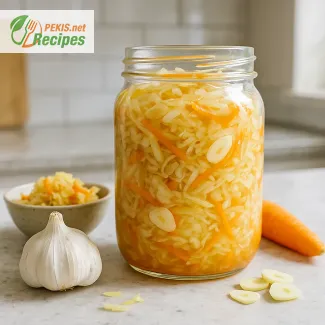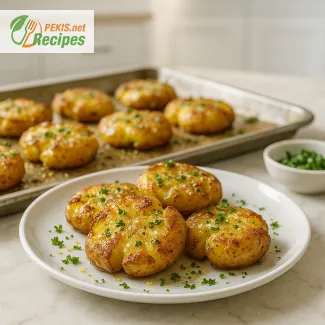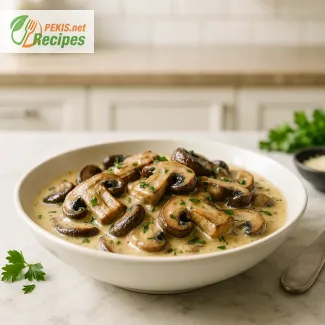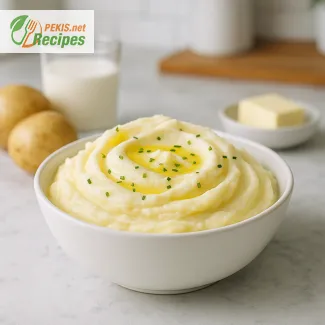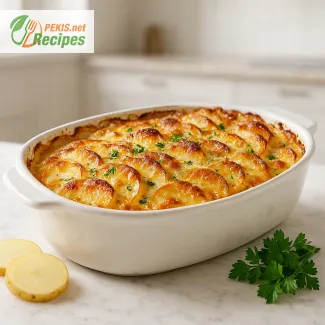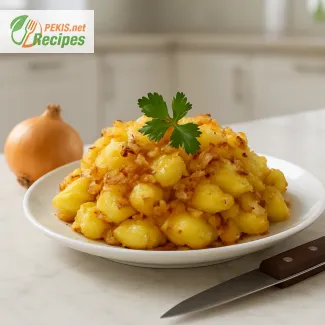Brussels sprouts for 4 servings come together in just 10 minutes of prep and 15 minutes of cooking, creating a tender, golden, and nutty side dish. Blanched briefly, then sautéed with olive oil, butter, and garlic, they develop a perfect balance of sweetness and crispness. A touch of lemon juice brightens the flavor, while Parmesan and a drizzle of balsamic glaze add richness. Best enjoyed fresh, these sprouts can also be stored for up to 3 days and easily reheated without losing texture — an ideal, quick, and flavorful addition to any meal.
Experimenting with Brussels sprouts over the years has taught how much technique changes everything — from mushy and bitter to perfectly caramelized and flavorful. A simple adjustment in timing or heat turns them into something that feels almost gourmet, even when cooked on a weekday evening. The balance between olive oil, garlic, and a hint of lemon brings out their natural sweetness, proving that great flavor often comes from small details and patience.
PEKIS – a professional chef and recipe developer with more than 25 years of experience in cooking and baking, specializing in European and international cuisine.
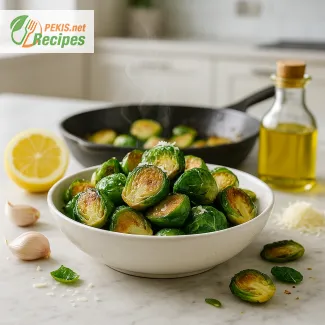
Mastering the Art of Cooking Brussels Sprouts at Home
Discover the secrets to perfectly tender, flavorful Brussels sprouts with golden edges and a rich, nutty aroma
Few vegetables transform so dramatically with the right cooking technique as Brussels sprouts. When handled properly, their natural sweetness and delicate nutty flavor emerge beautifully, replacing the bitterness many remember from overboiled childhood versions. These miniature cabbages belong to the cruciferous family, close relatives of cabbage, kale, and broccoli. The goal when cooking them is to achieve that ideal balance — tender inside, lightly crisp or caramelized outside, bursting with flavor and freshness.
Modern cooking has revived this humble vegetable into a culinary favorite — whether roasted, steamed, sautéed, or boiled, Brussels sprouts can shine as a versatile side or even the star of the plate. The key lies in controlling heat and moisture, and pairing them with ingredients that highlight their earthy yet subtly sweet notes. Olive oil, butter, garlic, lemon juice, or a touch of balsamic glaze can elevate their taste from simple to extraordinary.
The flavor transformation of Brussels sprouts
When heat meets Brussels sprouts, something magical happens. Their natural sugars caramelize, softening the leaves and deepening their flavor profile. A quick boil softens their texture, while roasting intensifies their sweetness. Many chefs blanch them briefly before finishing with a pan-sear, locking in both tenderness and vibrant green color. The result is a dish that feels hearty yet fresh — a perfect balance for both weeknight dinners and elegant holiday meals.
The bitterness often associated with Brussels sprouts comes from compounds that are heat-sensitive. Cooking them properly — neither too long nor too short — ensures those compounds mellow into a pleasant savory complexity. Add a squeeze of lemon or a drizzle of honey to balance flavors, and the taste becomes bright and layered.
A brief look at their origin and culinary history
Brussels sprouts trace their roots to Belgium, where they were first cultivated near Brussels in the 16th century. Their popularity spread through Northern Europe, later becoming a staple in British and American kitchens. Once considered a winter vegetable, they are now available year-round, though their peak season remains the colder months, when frost enhances their sweetness. Traditionally boiled or steamed, modern recipes often favor roasting for a caramelized surface and robust flavor.
These sprouts have become a symbol of seasonal home cooking — a reminder of comfort, warmth, and mindful eating. Their renewed reputation in contemporary cuisine is due to a growing appreciation for vegetables that are both flavorful and nutrient-dense, easily paired with meats, grains, or plant-based dishes.
Why you’ll love this recipe
- Tender texture with crisp, golden edges that add depth to every bite.
- Naturally sweet and nutty flavor that pairs beautifully with almost any main dish.
- Quick to prepare, making it a simple addition to weeknight meals.
- Versatile — can be served warm or chilled, plain or dressed with creative sauces.
- Seasonal comfort food that transitions seamlessly from autumn dinners to festive tables.
Ingredient synergy and key flavor notes
Brussels sprouts respond beautifully to contrasts — a balance of fat, acid, and umami. Cooking them with butter or olive oil enhances richness and texture. Garlic, onions, or shallots deepen the savory notes, while lemon juice or apple cider vinegar brings brightness that cuts through their density. Adding crisp bacon, toasted nuts, or Parmesan shavings introduces saltiness and crunch, creating a complete flavor spectrum.
For a vegetarian twist, try pairing them with roasted sweet potatoes or quinoa, using their robust character to complement softer, milder ingredients.
Storing and preparing ahead
Brussels sprouts keep well when stored correctly. Fresh ones should have tight, bright green leaves and a firm stem. Store them unwashed in the refrigerator in a breathable bag for up to one week. If you plan to cook in advance, parboil them briefly, cool, and refrigerate — this method saves time and preserves color and texture. When ready to serve, simply reheat with a touch of butter or oil to restore their glossy finish.
Leftovers can be enjoyed cold in grain bowls or salads, where their dense structure holds up well against dressings. Avoid overcooking during reheating to keep them from turning mushy.
Flavor variations and creative versions
- Roasted with honey and chili flakes – for a sweet and spicy contrast.
- Tossed with maple syrup and crushed walnuts – a cozy autumn-inspired side.
- Pan-fried with pancetta and balsamic glaze – for a rich, umami depth.
- Steamed with lemon zest and herbs – for a light, refreshing touch.
- Mixed with caramelized onions and garlic butter – comfort food at its best.
Culinary entities and pairings
Brussels sprouts (Brassica oleracea var. gemmifera) pair exceptionally well with:
- Citrus fruits – like lemon or orange, to enhance brightness.
- Nuts – such as almonds, pecans, or hazelnuts, for texture.
- Aged cheeses – including Parmesan or Gruyère, to enrich flavor.
- Proteins – roast chicken, beef, or tofu for balanced meals.
- Sauces – creamy mustard or balsamic reduction for an aromatic finish.
Bringing it all together
Perfect Brussels sprouts are all about balance — between texture and flavor, sweetness and earthiness, simplicity and sophistication. Once you understand how heat, oil, and time interact, you can transform this everyday vegetable into something extraordinary. Whether served as a side dish, part of a vegetable medley, or even as the centerpiece of a plant-based meal, they embody the idea that true flavor comes from precision and care.
- Rinse the Brussels sprouts thoroughly and remove any damaged outer leaves. Trim the stems slightly and cut larger sprouts in half for even cooking.
- Bring a pot of salted water to a boil. Add the sprouts and blanch for 3–4 minutes until just tender but still bright green. Drain immediately and pat dry with a paper towel.
- Heat olive oil and butter in a large skillet over medium heat (approx. 180 °C / 356 °F). Add the blanched sprouts cut side down and cook for 6–8 minutes until the edges are golden brown and slightly crisp.
- Add minced garlic and sauté for 1 minute until fragrant. Stir gently to coat the sprouts evenly.
- Season with salt and black pepper, then drizzle with lemon juice to balance the flavors. Toss lightly to combine.
- Transfer to a serving bowl, sprinkle with grated Parmesan, and drizzle with balsamic glaze (optional) for a glossy finish. Serve immediately while warm.
FAQ questionHow do I keep Brussels sprouts from tasting bitter?
Bitterness comes from sulfur compounds that intensify with overcooking. Use a quick blanch (3–4 minutes), then high-heat sauté to caramelize surface sugars and mute harsh notes. Balancing with acid (lemon juice or apple cider vinegar) and a touch of fat (olive oil or butter) rounds off any residual bitterness. Season at the end to avoid drawing out excess moisture during cooking.
FAQ questionShould I blanch before sautéing, and for how long?
Yes, a brief blanch ensures a tender interior without burning the exterior. Boil in salted water for 3–4 minutes until bright green and just tender, then drain and pat completely dry so they sear instead of steam. Finish in a hot skillet to get golden, crisp edges and concentrated flavor.
FAQ questionFresh vs. frozen Brussels sprouts — what changes in cooking?
Fresh sprouts give the best texture and caramelization. If using frozen, thaw and dry thoroughly before cooking; excess water prevents browning. Skip blanching frozen sprouts and go straight to a hot pan roast with oil, cooking a bit longer so surface moisture evaporates and browning develops.
FAQ questionHow do I know when they’re perfectly cooked?
Look for deep golden edges, vibrant green leaves, and a fork-tender core that still has a slight bite. In the skillet, this usually means 6–8 minutes after blanching. If the centers feel crunchy, give them another minute; if they’re dull olive green and limp, they went too far.
FAQ questionWhat are the best seasoning combos besides garlic and lemon?
For savory depth, use shallots + Dijon; for sweet-spicy contrast, try honey or maple + chili flakes; for umami, add Parmesan or a splash of soy sauce; for crunch, finish with toasted almonds, pecans, or hazelnuts. For dairy-free, swap butter with olive oil; for gluten-free, choose a certified GF balsamic glaze or skip it altogether.
FAQ questionHow should I store and reheat without losing texture?
Refrigerate cooked sprouts in a shallow, airtight container for up to 3 days. Reheat in a hot skillet with a teaspoon of oil to revive crisp edges, or use a 200 °C (392 °F) oven for 5–7 minutes on a sheet pan. Avoid microwaving if possible—it softens them and dulls caramelization.
Perfectly cooked Brussels sprouts are proof that simplicity and precision create remarkable flavor. When treated with care, their natural sweetness and nutty aroma come forward beautifully, offering a balance of crisp edges and a tender interior that fits any meal — from weekday dinners to festive tables.
Using fresh ingredients and understanding how heat transforms them is key. A quick blanch, a hot sauté, and the right finishing touches — lemon juice, garlic, and olive oil — elevate this vegetable from ordinary to memorable. Each step builds depth, turning something humble into a dish that feels intentionally crafted.
Brussels sprouts complement an endless variety of flavors. Whether paired with savory meats, creamy sauces, or plant-based sides, they adapt gracefully, enhancing both texture and taste. Even a drizzle of balsamic glaze or a sprinkle of Parmesan can transform them into something extraordinary without extra effort.
Their versatility makes them more than just a side dish — they’re a culinary foundation for creativity in the kitchen. Cooked correctly, they stand out for their vibrant color, rich flavor, and comforting warmth, reminding us that even the simplest ingredients can shine when treated with attention and passion.
Allergens present in the recipe:
- Milk – contained in butter and Parmesan cheese.
- Gluten – may be present if using commercial balsamic glaze (check label).
Allergen and gluten substitution tips:
- Replace butter with dairy-free margarine or olive oil for a lactose-free version.
- Omit Parmesan or substitute with nutritional yeast for a vegan-friendly alternative.
- Use a certified gluten-free balsamic glaze or skip it entirely to make the dish gluten-free.
- Vitamin C – 75 mg – strengthens the immune system and supports collagen formation.
- Vitamin K – 156 µg – contributes to blood clotting and bone health.
- Folate (B9) – 61 µg – essential for cell repair and DNA synthesis.
- Potassium – 470 mg – supports normal muscle function and heart rhythm.
- Iron – 1.4 mg – promotes oxygen transport and reduces fatigue.
- Calcium – 58 mg – strengthens bones and teeth.
- Kaempferol – 22 mg – helps reduce inflammation and protect cells.
- Quercetin – 18 mg – supports cardiovascular health and immune defense.
- Alpha-lipoic acid – 3 mg – contributes to energy metabolism and detoxification.
- Beta-carotene – 0.2 mg – promotes healthy skin and vision.
- Lutein – 0.6 mg – supports eye health and reduces oxidative stress.
